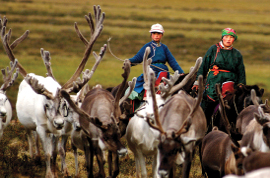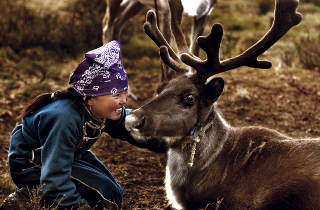Reindeer Rescuer
By Catherine O’Neill Grace
In a culture that hasn’t changed in centuries, Sophia Papageorgiou, V96, is helping preserve herders’ livelihoods

“The reindeer may be a sentinel group for what might be happening with climate change in the coming decades,” says Sophia Papageorgiou. Photo: Donna Todd
When Sophia Papageorgiou, V96, heads off to do fieldwork in Mongolia, she doesn’t simply leave one country for another. She travels back centuries. A trek that begins on a jet out of San Francisco moves to ever-smaller planes, then to a van rattling along rutted roads, and ends with a daylong horseback ride into the taiga, the forested region of Khövsgöl, the country’s northernmost province. “I am on horseback the entire time I am in the taiga,” she says.
The Mongolian taiga, where 250 semi-nomadic herders depend on 800 reindeer for survival, is on a collision course with the 21st century.
The taiga, the world’s largest ecosystem, cuts across large swaths of Canada, Europe and Asia. Taiga winters are six months long and extremely cold. Most of the precipitation falls during the short, humid summers.
The remoteness of the Mongolian taiga, which straddles the country’s border with Russian Siberia, limits the herders’ access to regular veterinary care for their animals. Gold miners, hunters and loggers have entered the region, disrupting the fragile ecosystem.
But perhaps a greater threat to the way of life of the Mongolian Tsaatan—the reindeer people—is climate change. “The 60-year-old herders say we don’t have snow in May anymore,” reports Papageorgiou. “Reindeer need the cold weather. Without it, they
cannot thrive.”
If warming trends observed over the last 20 years continue, the reindeer will become even more vulnerable to the tick-borne diseases that already threaten them. Supplies of lichen, their primary winter-foraging food, will diminish. “The reindeer may be a sentinel group for what might be happening with climate change in the coming decades,” says Papageorgiou, who is doing postdoctoral research in epidemiology at UC Davis School of Veterinary Medicine.
Herds Under Stress

Life revolves around the reindeer in the Mongolian taiga. Photo: Donna Todd
It was the ticks that brought Papageorgiou to Mongolia, where she worked with the Reindeer Life Project, an initiative of the Itgel Foundation that supports the Tsaatan and their animals.
The reindeer face several health challenges, including reproductive problems and lameness. These ailments, Papageorgiou says, could result from tick-borne infections such as Lyme disease, or the parasite anaplasmosis, both of which produce a constellation of flu-like symptoms in animals and humans. The highly contagious bacterial infection brucellosis could be contributing to the animals’ reproductive problems, she says.
Papageorgiou says she was the first to identify “a suite of three tick-borne pathogens” in the Mongolian reindeer as part of her doctoral work, which was supported in part by the Morris Animal Foundation. “My interest focuses on the complexity of infectious diseases and their interaction with the environment,” she notes.
The Tsaatan culture has remained virtually unchanged for 10,000 years, according to the United Nations Educational, Scientific and Cultural Organization (UNESCO). Three-thousand-year-old petroglyphs, depicting reindeer and herders, can still be found in the region.
The Tsaatan are Mongolia’s smallest ethnic minority, with a population of about 500 people comprising 30 to 45 family units. They speak Tuvan and practice shamanism. And they rely on their reindeer: for the milk, which is also used to make cheese; for their antlers, which are fashioned into tools; and for transportation. Unlike some other herding cultures, the Tsaatan rarely eat reindeer meat, instead hunting the increasingly scarce taiga wild game, such as elk or moose.
Historically, the herding community migrated between northern Mongolia and southern Siberia, as often as five or 10 times each year. But in 1921, the Mongolian People’s Revolutionary Party, modeled on the Soviet Communist Party, was established, and the Mongolian-Siberian border was closed in the 1930s, confining the Tsaatan to a smaller piece of the taiga.
“The reindeer are free-ranging,” says Papageorgiou. “There are no corrals or pastures.” The animals she studied are the southernmost reindeer in the world. Reindeer-herding cultures do exist in other northern locales, such as Scandinavia and Russia where herders keep domesticated herds totaling some two million animals.
Papageorgiou is continuing her research in the taiga, this time focusing on the rodent population to determine which species may serve as reservoirs for tick-borne illnesses.
She says she treasures the time she has spent—and the gallons of reindeer milk tea she has shared—with the people of the taiga. In addition to her own research, she serves as a veterinarian for the herds. She attributes much of the success of her experience with the Tsaatan to what she learned at the Cummings School.
“I used all the training in international veterinary medicine that I received at Tufts—how to work with the people on the ground and the awareness that you are a guest” in someone else’s country, she says. “I remembered all those principles, and I don’t think I would have been successful without that training.”
This story first appeared in the Spring 2010 Tufts Veterinary Medicine magazine.
